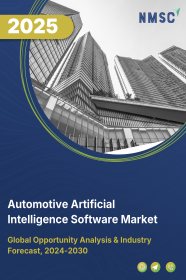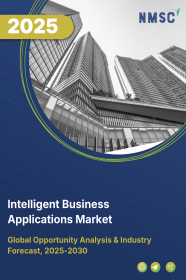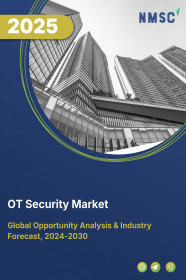
Automotive Artificial Intelligence Software Market by Process (Signal Recognition and Image Recognition), by Technology (Machine Learning & Deep Learning, Computer Vision, and Natural Language Processing), and by Application (Semi-Autonomous and Fully Autonomous) - Global Opportunity Analysis and Industry Forecast, 2022 – 2030
US Tariff Impact on Automotive Artificial Intelligence Software Market
Trump Tariffs Are Reshaping Global Business
Automotive Artificial Intelligence Software Market Overview
The global Automotive Artificial Intelligence (AI) Software Market size was valued at USD 7.32 billion in 2021 and is predicted to reach USD 55.40 billion by 2030 with a CAGR of 22.5% from 2022-2030. Automotive AI software is used in vehicles in the manufacturing process, driver assistance, and driver risk assessment systems. It is also used in various operations such as image processing, face recognition, and threat detection.
Automotive AI software had upgraded the capacity to gather information, impersonate the human brain, and ingest the tough spots using AI innovation. These systems assist in making the driving experience more helpful and ensure progressed security measures for both the driver as well as the travellers. The Automotive AI software helps in localization and integrated mapping of vehicles.
Market Dynamics and Trends
The demand for automotive artificial intelligence software (AAIS) is increasing, owing to rollout of the automotive industry with the combination of smart technologies such as Lidar and Long-Term Evolution (LTE). For instance, in December 2021, Valeo launched a new Mercedes-Benz S-Class equipped with Lidar, the second-generation LiDAR, and Valeo scala. Moreover, the use of Advanced Driver Assistance Systems (ADAS) in the automotive industry to improve safety with the help of embedded vision by reducing the occurrence of accidents and injury to occupants further boost the market growth.
For instance, in June 2022, Hyundai launched the robotaxi trial with its AV technology that was based on the internally developed advanced driver assistance system (ADAS). In addition, the growing demand for electric vehicle has boosted the EV manufacturers to in-built various software for better functionality and features in the vehicle which is expected to drive the growth of the Automotive AI Intelligent Software market during the forecast period.
For instance, in July 2022, Bright Drop, a subsidiary of General Motors integrated the AI-powered fleet optimization software ‘Marain Inc.’, which is designed to analyze, forecast, and identify multimodal solutions for fleet customers as they plan their journey to full-fleet electrification. However, the rise in cybercrime and increase in privacy concerns are some of the factors that are expected to restrain the growth of the market during the forecast period.
On the contrary, the introduction of ‘EBG-Matics’ that uses AI and machine learning to analyses rider and vehicle behavior to track and improve efficiency is expected to create lucrative growth opportunities for the automotive artificial intelligence software (AAIS) market in the future.
Market Segmentations and Scope of the Study
The global automotive artificial intelligence software market report is analysed on the basis of process, technology, application, and geography. Based on the process, the market is classified into signal recognition and image recognition. On the basis of technology, the market is divided into machine learning & deep learning, computer vision, and natural language processing. On the basis of application, the market is fragmented into semi-autonomous and fully autonomous. Geographic breakdown and analysis of each of the aforesaid segments include regions comprising North America, Europe, Asia-Pacific, and Row.
Geographical Analysis
North America holds the lion share in the Automotive AI software market at present and is expected to boost the market growth during the forecast period. The increasing initiatives of various automotive companies to launch fully autonomous cars is propelling the growth of Automotive AI software market growth in the region. For instance, in November 2021, Lyft and Motional signed a joint venture for commercializing autonomous driving technology and announced plans to launch their first fully driverless ride-hail service in Las Vegas in 2023.
Moreover, the launches of AI software for advancing the features and productivity of cars, and for ensuring safe & secure driving capabilities by various key manufacturers is expected to boost the market growth in the region. For instance, in March 2022, NVIDIA Corporation announced the production of its Nvidia drive Orin autonomous vehicle computer. The platform unveiled the next generation of its Nvidia drive Hyperion architecture. This solution will serve as the central nervous system and AI brain for new energy vehicles.
Asia Pacific is expected to show rapid growth in AI Software market, owing to expansion of software research centres in the region. For instance, in May 2022, the National Taipei University of Technology, known as Taiwan Tech, launched a research centre that would be a joint venture of private and public entities' research. This research centre focuses on key technologies such as AI software and adaptive cruise control that are used for propagation of self-driving cars. In addition, the presence of key manufacturers of automotive artificial intelligence software is adopting strategies such as product launches in the region further drives the market growth.
For instance, in January 2022, Honda invested in a software startup ‘Helm.ai’ to strengthen its computer vision and ai development. This software is used for vehicle perception systems for autonomous driving and advanced driver assist systems (ADAS) to identify objects and predict their movements. Helm.ai's core strengths are in the areas of advancing AI-based image recognition technologies through unsupervised learning.
Competitive Landscape
The automotive artificial intelligence software industry includes various market players such as Tesla Inc., NVIDIA Corporation, Apple Inc., IBM Corporation, Honda Motor Co, Intel Corporation, BMW, Toyota, Waymo, Otto Motors, and Microsoft Corporation. These market players are adopting various joint venture strategies and planning expansion of businesses across various regions to maintain their dominance in the automotive artificial intelligence software market.
For instance, in June 2022, OTTO Motors released software that gives customers better visibility and depth of fleet performance to support the world’s largest AMR deployments. It provides the users with sophisticated tools to analyse their system, identify risks, and optimize their AMR-driven material flow. Also, in January 2022, Tesla launched TeslaMic for its in-car karaoke system in China. It adds a karaoke platform ‘Leishi KTV’ to infotainment systems. It allows Tesla owners to access Leishi KTV's interface and catalogue via their EV's on-board computer to help out singers.
Automotive AI Software Market Key Segments
By Process
-
Signal Recognition
-
Image Recognition
By Technology
-
Machine Learning & Deep Learning
-
Computer Vision
-
Natural Language Processing
By Application
-
Semi-Autonomous
-
Fully Autonomous
By Geography
-
North America
-
U.S
-
Canada
-
Mexico
-
-
Europe
-
UK
-
Germany
-
France
-
Italy
-
Spain
-
Rest of Europe
-
-
Asia-Pacific
-
China
-
India
-
Japan
-
South Korea
-
Australia
-
Rest of Asia-Pacific
-
-
RoW
-
UAE
-
Saudi Arabia
-
South Africa
-
Brazil
-
Remaining Countries
-
Key Players
-
Tesla Inc
-
NVIDIA Corporation
-
Apple Inc
-
IBM Corporation
-
Honda Motor Co.
-
Intel Corporation
-
BMW
-
Toyota
-
Waymo
-
Otto Motors
-
Microsoft Corporation
REPORT SCOPE AND SEGMENTATION:
|
Parameters |
Details |
|
Analysis Period |
2021–2030 |
|
Base Year Considered |
2021 |
|
Forecast Period |
2022–2030 |
|
Market Size Estimation |
Billion (USD) |
|
Market Segmentation |
By Process (Signal Recognition and Image Recognition), by Technology (Machine Learning & Deep Learning, Computer Vision, and Natural Language Processing), and by Application (Semi-Autonomous and Fully Autonomous) |
|
Geographical Segmentation |
North America (U.S., Canada, Mexico) Europe (UK, Germany, France, Italy, Spain, Rest of Europe), Asia-Pacific (China, India, Japan, South Korea, Australia, Rest of Asia-Pacific), Rest of the World (UAE, Brazil, South Africa, Israel, KSA (UAE, Saudi Arabia, South Africa, Brazil, Remaining countries) |
|
Companies Profiled |
Tesla Inc., NVIDIA Corporation, Apple Inc., IBM Corporation, Honda Motor Co, Intel Corporation, BMW, Toyota, Waymo, Otto Motors, and Microsoft Corporation. |

















 Speak to Our Analyst
Speak to Our Analyst




















